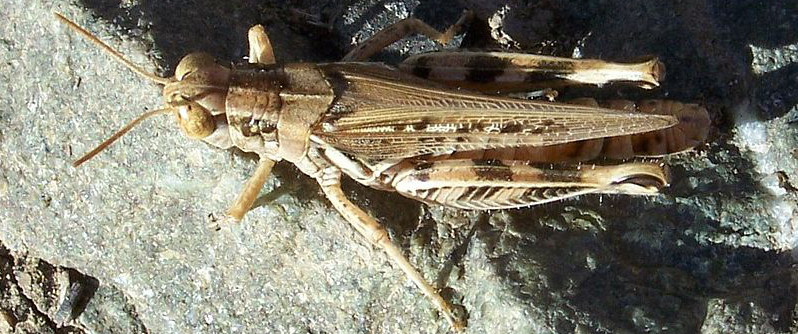
Reproduction
In terms of life history and reproduction, the devastating
grasshopper is very interesting. The Melanoplus devastator
has used its environment and the adaptions it has made to this
weather-shifting environment. They have some fascinating methods
of reproduction. The females go through reproductive diapause
during the hottest and dry parts of the summer (Orr et al.
1993). This sets them apart from their closely
related M. sanguinipes and is one of the main reasons
why they are not the same species. The devastating grasshoppers
emerge in the early to mid April where they grow to adults in
July where they then enter this reproductive diapause (Roff and
Mousseau 2005). Roff and Mousseau also stated that the
grasshoppers then stay in reproductive diapause until September
or October. During this time, the fall rain starts to come; this
rain begins the growth of plants and much needed nutrients that
helps push the grasshoppers out of this reproductive diapause
The shortening of days also kicks starts the development of the
female eggs (Pfadt 1994). Elevation also plays a factor in the
reproductive habits, hatching, and development (Dingle and
Mousseau 1993). At lower elevations, the development is slowed
and the devastating grasshoppers grow larger because they
experience a more sheltered environment, and with a larger body
size come a longer lifespan (Tatar et al. 1997). The
season length has a big impact on their life history especially
in the Sierra Nevada and the soils there, because the devastator
eggs hatch later in the season (Orr 1996). Once the grasshoppers
come out of the reproductive diapause the females begin to lay
their eggs. The eggs are laid in the soil and usually in the
gravel soil on the ridges and slopes of the foothills in their
rangeland habitat (Pfad
where they then enter this reproductive diapause (Roff and
Mousseau 2005). Roff and Mousseau also stated that the
grasshoppers then stay in reproductive diapause until September
or October. During this time, the fall rain starts to come; this
rain begins the growth of plants and much needed nutrients that
helps push the grasshoppers out of this reproductive diapause
The shortening of days also kicks starts the development of the
female eggs (Pfadt 1994). Elevation also plays a factor in the
reproductive habits, hatching, and development (Dingle and
Mousseau 1993). At lower elevations, the development is slowed
and the devastating grasshoppers grow larger because they
experience a more sheltered environment, and with a larger body
size come a longer lifespan (Tatar et al. 1997). The
season length has a big impact on their life history especially
in the Sierra Nevada and the soils there, because the devastator
eggs hatch later in the season (Orr 1996). Once the grasshoppers
come out of the reproductive diapause the females begin to lay
their eggs. The eggs are laid in the soil and usually in the
gravel soil on the ridges and slopes of the foothills in their
rangeland habitat (Pfad t 1994). The eggs are laid in relatively
small areas, and are kept pretty close between one another. Once
the temperatures become too cold, the adult grasshoppers die and
the eggs are left in the soil until April where their life cycle
starts over again.
t 1994). The eggs are laid in relatively
small areas, and are kept pretty close between one another. Once
the temperatures become too cold, the adult grasshoppers die and
the eggs are left in the soil until April where their life cycle
starts over again.
The
reproduction of the Melanoplus devastator depends
heavily on the environment. Temperature is one of the biggest
factors for the devastating grasshopper. A reason for natural
selection that takes place in these grasshoppers depends heavily
on the temperature that it is in throughout most of its life
(Roff and Mousseau 2005). The amount of water that is in the
environment surrounding this grasshopper plays hand in hand with
the temperatures that area has seen in the season. Roff and
Mousseau went on to state that the water rates affect the
metabolic systems of the grasshopper and the temperature also
effects season length. All of these in turn affect the way in
which this organism reproduces. As mentioned before, the
altitude plays a role in the reproduction of these animals as
well. The lower the altitude the higher the temperature, and
this is why this specific grasshopper has adapted to the warmer
climates.
It is all
very interesting to see the kinds of ways that this organism
reproduces. Their reproductive behavior sets them apart from
other closely related species. It is also unique that they
adapted to the environment rather than moving to an environment
that they had been previously adapted to. They are very well
adapted to the area that they live in and it may be one of the
reasons why it is hard to see them outside of their natural
habitat in the Northwest United States.
Move back to Form and Function Home Page Move on to Interactions